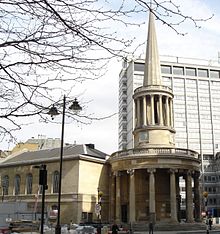Regency architecture



Regency architecture encompasses classical buildings built in the
The style is strictly the late phase of Georgian architecture, and follows closely on from the neo-classical style of the preceding years, which continued to be produced throughout the period. The Georgian period takes its name from the four Kings George of the period 1714–1830, including King George IV. The British Regency strictly lasted only from 1811 to 1820, but the term is applied to architecture more widely, both before 1811 and after 1820;[2] the next reign, of William IV from 1830 to 1837, has not been given its own stylistic descriptor. Regency architecture is especially distinctive in its houses, and also marked by an increase in the use of a range of eclectic Revival styles, from Gothic through Greek to Indian, as alternatives to the main neoclassical stream.
The opening years of the style were marked by greatly reduced levels of building because of the
Houses
Many buildings of the Regency style have a white painted
For large
Churches
Until the
Public buildings
The period saw a great increase in public buildings, at both the national and local level.[9] In London, three bridges were built over the Thames between 1813 and 1819: Vauxhall Bridge, Waterloo Bridge and Southwark Bridge, all privately financed by toll charges.[10] Shops began to be included systematically into newly planned developments, and the covered arcade of shops was introduced, with the Burlington Arcade in London (1815–19) the earliest.[11]
Leading architects

The public buildings of George Dance the Younger, City Architect of London from 1768, were precursors of the Regency style, though he designed little himself after 1798. Robert Smirke could produce both classical (British Museum) and Gothic designs, and also mainly worked on public buildings. With Nash and Soane he was one of the Board of Works' architects during the peak Regency period. A large commission of the period was the expansion of Windsor Castle for the king, which eventually cost over a million pounds, over three times the original budget. Smirke, Nash, Soane and Jeffry Wyatville were invited to tender, Wyatville winning the competition. He was a prolific designer, mostly for country houses, new-built or refurbished, able to work in a variety of styles. His uncle James Wyatt was a leading architect of the previous generation, and James' sons Benjamin Dean Wyatt and Philip Wyatt were also successful architects in the period.
Locations
Apart from London, a number of English towns hold especial concentrations of Regency architecture. Several of the least-spoiled of these are new resort towns, attempting to emulate the success of
Excellent examples of Regency properties dominate
-
Park Crescent, London
-
Regency houses, now municipal buildings in Cheltenham
-
The Parade, Leamington Spa
-
Lansdowne Crescent, Leamington Spa
-
Suburban "villa" in Edgbaston, a suburb of Birmingham, 1820s
-
Smaller semi-detached villas with Gothic details, Dawlish
See also
Notes
- ^ The Encyclopedia Americana, Grolier, 1981, v. 9, p. 314
- ^ Summerson, 135
- ^ Summerson, 135
- ^ Summerson, 166
- ^ Summerson, 135, 146, 189–191, 206, 225–233
- ^ Norwich, 248–249
- ^ Norwich, 631
- ^ Summerson, 212–221; Strong, 503–504
- ^ Summerson, 189–203, 225–251; Strong, 504–505
- ^ Summerson, 233–236
- ^ Summerson, 259–260
- ^ Summerson, 162–180; Strong, 502
- ^ Summerson, 95–97
- ^ Stong, 503, quoted; Norwich, 222–223
- ^ Norwich, 630–631
References
- ISBN 0712636137
- ISBN 0-7139-9281-6
- ISBN 0-7139-9596-3
- ISBN 009190076X
- ISBN 0333220374
- Pevsner, Nikolaus. The Englishness of English Art, Penguin, 1964 edn.
- ISBN 185681534X
- Sir ISBN 0712620958. (Also see revised edition, edited by Howard Colvin, 2003)
External links
- Regency Society, a Brighton & Hovegroup promoting preservation of Regency architecture
- "Regency Classicism Style Guide". British Galleries. Victoria and Albert Museum. Retrieved 17 July 2007.






